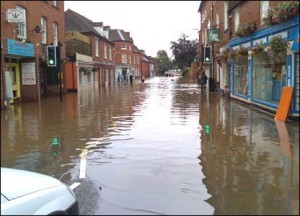Articles
Flood Risk in the City
Tweet
By Simon Mills, Head of Sustainable Development, City of London
Thanks to the Romans’ eye for a prime piece of real-estate, the City of London is a relatively low risk of flooding from the Thames (picture on the left: City of London circa 180AD).
In the unlikely event of overtopping of the Embankment only a narrow strip of the City, closest to the river would get its feet wet- though the transport impacts from flooded tube and railway lines would cause serious disruption!
Of more concern are the impacts of surface water and sewer flooding, but we do have form on dealing with this.
In early 2007, following the publication of the City of London’s Climate Change Adaptation Strategy (the world’s first adaptation strategy for an urban area) the City of London Corporation commissioned Mouchel Parkman to undertake one of the UK’s first Strategic Flood Risk Assessments.
Over the summer of 2007, the UK suffered flooding on an unprecedented scale, leaving 13 people dead, 44,600 homes flooded and causing in excess of £3bn in damage. In response to this event, DEFRA commissioned an independent review of flood management by Sir Michael Pitt which was published in the summer of 2008. The Government accepted all of the Report’s recommendations and in response signed the Flood and Water Management Act into law in 2010.

Above: Flooding near Tewksbury, Gloustershire (source bbc.co.uk)
Under the provisions of the act the City of London is a Lead Local Flood Authority (LLFA) with a duty to take a ‘lead’ role in managing flood risk from surface water, groundwater and ordinary watercourses within its boundaries. This involves close working with partners involved in flood and water management, known as Risk Management Authorities.
The City’s main duties involve
– Applying and monitoring a Local Flood Risk Management Strategy.
– Cooperating with other ‘Risk Management Authorities’, include London boroughs, the GLA, Thames Water, the Environment Agency and others.
– Maintaining a register of local structures and features that are likely to have a significant effect on flood risk.
– In the event of a significant flood, investigating to an appropriate level whether the relevant flood risk management functions were exercised correctly.
– Contributing towards sustainable development when exercising a flood risk management function.
– Acting as the Sustainable Drainage Approving Body.
The City of London is also Category 1 responder under the Civil Contingencies Act and is responsible for warning and informing the public about flooding.
In the event of an emergency, the City will work together with other agencies including the emergency services and neighbouring Local Authorities to respond as set out within the Multi Agency Flood Plan and the City’s Emergency Management Plan.
Because the City is primarily a business district, (our residential population in only 7500, though over 350,000 people commute here to work every day), we have put a lot of effort into engaging our business community.
We have a corporate-wide Flood Risk Steering Group which enables joined up working across departments. This integrated approach ensures that new developments within the City are flood resistant and resilient, and to prepare existing properties at risk of flooding and improve their resilience to flooding. This is one of the reasons that the City boasts one of the highest concentrations of green roofs in the country.
Our Security and Contingency Planning team assists City businesses with incorporating flood risk into their business continuity and emergency plans. Further information about accessing this support can be found on the City’s website via this link.
And finally using Drain London funding we created a Flood Resistance and Resilience Officer post to work with City businesses, residents and different departments within the City of London Corporation to reduce the vulnerability and raise awareness of surface water flooding in the City. Funding for this post ended in July of this year, with the publication of a series of flood resistance case studies for businesses in the square mile, but the initiative was so successful that the City of London is continuing to fund this post for another year.
If I were to sum up the learning from the last 7 years, I would say that whilst, in the City, flooding is rare, the consequences could be significant, so a combination of hard engineering, soft systems and education can mitigate risks and ensure that businesses can effectively and rapidly recover from the effects of flooding.
This site is seriously amazing.
Blog is unique and perfect. Thanks for sharing.